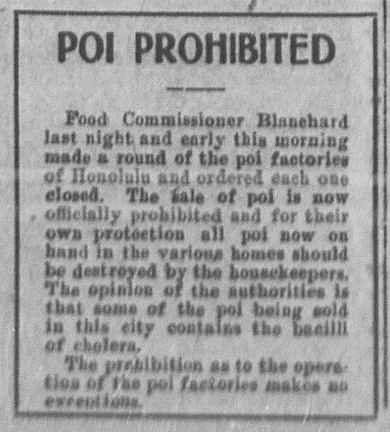"The sale of poi is now officially prohibited."
Thus was the March 2, 1911 directive of Food Commissioner Blanchard (as noted in an announcement on the front page of the Hawaiian Gazette, March 3, 1911.) (While not being sold, there was still plenty of poi available to consumption.)
"Over seventy-five hundred pounds of poi is being distributed free every day to Hawaiians in this city by the board of health under a resolution by the legislature appropriating $2000 out of the contingent fund for the expense subject to the approval of the Governor." (Hawaiian Gazette, March 10, 1911)
"About one ton of poi a day is given out at each of the four stations Kalihi, Palama, Mōʻiliʻili and Kawaiahaʻo Church. At each place there is a health inspector representing the board of health who is in charge of the operation assisted by deputies of Mr Rath superintendent of the Palama settlement work, who is superintending the poi distribution." (Hawaiian Gazette, March 10, 1911)
"At first the distribution was in the shape of sacks of poi of about ten pounds each put up at the Kalihi factory but such a great demand was immediately developed that the factory had no time to sack the poi and now it is being sent to the distributing points in barrels." (Hawaiian Gazette, March 10, 1911)
"A number of bacteriological tests made with poi have convinced the health officers of the territorial and federal government that that staple can transmit and impart the germs of cholera and probably all other disease of similar nature." (Hawaiian Gazette, March 17, 1911)
"With but two exceptions every case of cholera in the two outbreaks during the past two months has been traced to one source of infection - the Manoa valley taro patches and the poi manufactured from this taro." (Hawaiian Gazette, April 18, 1911)
"In Manoa valley is a Chinese named Hong Fong who had a taro patch. He carried taro to a shop on Fort street near School. This was made into poi and each day he carried poi from this shop up to Manoa and delivered it to Manana and Mrs Gonsalves who were the first of the Manoa cases." (Hawaiian Gazette, April 18, 1911)
"Then comes the Perry family cases in Manoa where cholera wiped out almost an entire family. There were four cases of cholera. They lived on the bank near this taro field. They raised their own taro but sometimes bought poi from Hong Fong. They filled their water barrels for drinking purposes from this stream which had been contaminated by Manana when he became sick." (Hawaiian Gazette, April 18, 1911)
"In this stream Manana's contaminated clothing was washed by members of his family and water from this polluted stream was used to mix with poi. A Japanese dairyman nearby used this water to dilute the milk product and the children in the Perry family drank milk so diluted and contaminated." (Hawaiian Gazette, April 18, 1911)
"From February 25, when the first case was reported, to March 14, 1911, the date of the last case, there had been reported a total of 31-cases with 22 deaths. Twenty four days having elapsed since the occurrence of the last case, Honolulu may properly be considered to no longer harbor the disease." (Public Health Reports)
The medical conditions led the territorial legislature to enact regulations on the processing of poi. The "Poi Bill" gave the board of health the authority to close any poi shop which is found to be making poi under filthy and disease-breeding conditions (the first law to regulate poi factories.)
This is not the Islands' last legislative fight over processing poi.
A hundred years later, in 2011, another "Poi Bill" (SB101) was enacted after it made its way through the legislature and onto the Governor's desk.
It exempted paʻi ʻai (traditional "hand-pounded poi") from certain food-processing requirements/permits under certain conditions. (Up to that passage, the Department of Health deemed paʻi ʻai unsafe.)
(Cholera is an infection of the small intestine caused by the bacteria; the main symptoms are watery diarrhea and vomiting. It is typically transmitted by either contaminated food or water. Worldwide, there have been several cholera pandemics, killing millions of people.)
The image shows Food Commissioner's Poi Prohibition proclamation. (Hawaiian Gazette, March 3, 1911) In addition, I have added other images in a folder of like name in the Photos section on my Facebook and Google+ pages.
Follow Peter T Young on Facebook
Follow Peter T Young on Google+
© 2014 Hoʻokuleana LLC

No comments:
Post a Comment